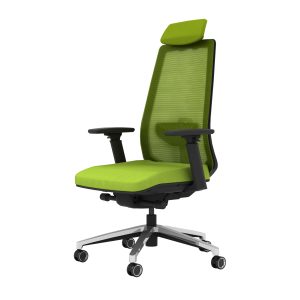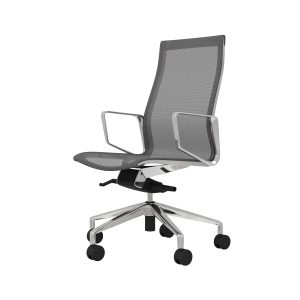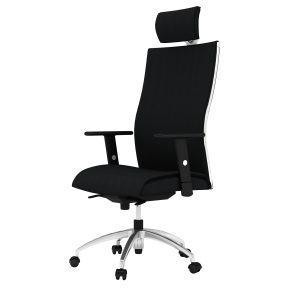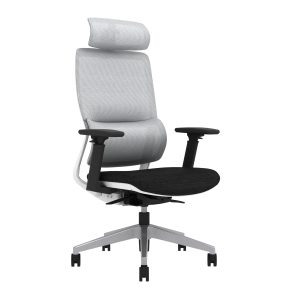
Ergonomic Chairs
Furniture with ergonomic features refers to furniture that has been meticulously crafted to provide the highest level of comfort and support to individuals using it. This type of furniture is engineered with careful consideration of the natural postures and movements of the human body, to reduce physical strain, enhance efficiency, and promote overall well-being.
Ergonomically designed furniture often includes adjustable features, such as office chairs with customizable seating positions and desks with height-adjustable surfaces, allowing users to personalize their furniture to meet their specific requirements.
Artmatrix, Malaysia office chair supplier offers a selection of ergonomically designed chair and furniture solutions that prioritize user comfort and functionality, making them an excellent choice for creating a healthier and more productive workspace.
Ergonomic Adjustments for Comfortable Work
Ergonomic adjustments in office chairs are designed to provide users with the flexibility to customize their seating experience for maximum comfort and support. These adjustments typically include height adjustment to accommodate users of varying heights. Additionally, many office chairs are equipped with a tilt mechanism, which can be in the form of knee tilt or synchro tilt, allowing users to recline and find their preferred seating angle.
While these are common ergonomic adjustments, the possibilities for customization are extensive. Office furniture constantly evolves, introducing new innovations. For now, users have the freedom to mix and match these standard features to create a personalized and comfortable seating arrangement that suits their individual preferences and needs.
Ergonomic adjustments are specialized features designed to optimize your comfort and posture while working. While not all adjustments are essential for everyone, they can address specific issues and contribute to overall body support.
Seat
- Adjustable Seat Height: Customize the seat height to ensure your feet comfortably rest on the ground, regardless of your height. For petite users, consider a petite office chair, and for taller users, a big and tall office chair for maximum comfort.
- Adjustable Seat Depth: Tailor the seat depth to accommodate taller individuals, preventing thigh pressure. Most chairs offer 2-3 inches of adjustability to suit various users.
Back
- Adjustable Arm Height: Maintain relaxed shoulders with arms parallel to the ground. Avoid shoulder strain caused by high armrests or stress on your elbows due to low armrests.
- Adjustable Back Height: Support your spine with a chair that offers adjustable back height. Ensure the chair’s lumbar curve aligns with your lower back.
- Adjustable Lumbar Support: Find lumbar support adjustment via a ratcheting column on the chair’s back, allowing you to customize lower back support.
- Adjustable Headrest: Reduce neck strain during recline by opting for a chair with a headrest, ideal for those experiencing constant neck discomfort.
Arms
- Flip Arms: Enjoy flexibility with arms that can be flipped up, down, or to the side. This feature allows for easy movement and accessibility to your workspace.
- Adjustable Arm Width: Customize arm width for a natural and comfortable arm position, preventing discomfort from your sides pushing against the chair’s arms.
- Adjustable Arm Depth: Modify arm depth to control forward and backward arm movement. Ensure your arms are supported at the elbows, not the wrists.
- Adjustable Arm Pivot: Pivoting arms address arm depth and width issues, accommodating specific tasks and providing ample space.
- Adjustable Arm Pad Depth: Choose the level of armrest padding that suits your comfort preferences.
- Adjustable Arm Pad Pivot: Enhance cushioned comfort for your arms during work.
Tilt
- Synchro Tilt: Achieve proper posture while reclining with a 2:1 ratio synchronized back and seat movement, ensuring your feet stay flat on the ground.
- Knee Tilt: Keep your feet flat on the ground with a front-pivoting knee tilt mechanism, reducing leg pressure and fatigue.
- Single-Point Tilt: Found in budget chairs, this tilt maintains the angle between the back and seat. Adjustable tension can improve comfort.
- Tilt Lock: Lock your chair in your desired recline position without exerting pressure.
- Adjustable Tilt Tension: Control the force required to tilt or recline in the chair, customizing your comfort level. Choose based on your preference, from easy recline to firm support.
Essential Checklist for Ergonomic Chairs
Here’s a list of essential checklist items for ergonomic chairs:
- Adjustable Seat Height: Ensure the chair can be easily adjusted to your preferred height.
- Adjustable Seat Depth: Look for a chair that accommodates your leg length with adjustable seat depth.
- Lumbar Support: Check if the chair provides proper lumbar support for your lower back.
- Armrest Adjustability: Ensure the armrests are adjustable in height and width.
- Seat Pan Size: Make sure the seat pan size fits your body comfortably.
- Seat Material: Consider the type of material used for the seat (e.g., breathable fabric, cushioned padding).
- Backrest Shape: Evaluate the shape of the backrest and its compatibility with your spine.
- Headrest: Decide if you prefer a chair with or without a headrest for neck support.
- Swivel and Casters: Ensure the chair swivels easily and has smooth-rolling casters.
- Tilt Mechanism: Check for a synchronized tilt or knee tilt mechanism for reclining.
- Tilt Lock: Determine if the chair offers a tilt lock feature to secure your preferred angle.
- Tilt Tension Control: Look for adjustable tilt tension to customize reclining resistance.
- Material Quality: Assess the overall build quality and durability of the chair.
- Weight Capacity: Ensure the chair can support your body weight comfortably.
- Armrest Padding: Check if the armrests have sufficient padding for comfort.
- Seat Edge Design: Look for a waterfall seat edge to reduce pressure on the legs.
- Warranty: Review the warranty terms and coverage for added peace of mind.
- Price: Consider your budget and find a chair that offers the best value.
- User Reviews: Research user reviews and testimonials for real-world feedback.
- Ergonomic Certification: Confirm if the chair meets ergonomic standards.


WHY CHOOSE ARTMATRIX AS YOUR ERGONOMIC CHAIR SUPPLIER?
Opting for ARTMATRIX TECHNOLOGY as your ergonomic chair supplier can offer numerous advantages. They specialize in a vast array of ergonomically designed chairs that prioritize comfort, support, and versatility.
Their products are tailored to enhance the health and productivity of your workspace, featuring customizable options and adjustments to meet individual needs. This focus on ergonomic solutions makes ARTMATRIX a compelling choice for those seeking to improve their seating and overall workspace ergonomics, making them a top office chair supplier in the market.
FREQUENTLY ASKED QUESTIONS ABOUT ERGONOMIC
What are the correct ergonomics for a chair?
- Adjustable Seat Height: The chair’s height should allow your feet to rest flat on the ground or on a footrest.
- Lumbar Support: Ensure proper lower back support to maintain the natural curve of your spine.
- Adjustable Armrests: Armrests should be at elbow height, allowing your arms to rest comfortably.
- Seat Depth: Opt for a seat with adjustable depth to support your thighs without pressure.
- Tilt Mechanism: Chairs with synchronized or knee tilt help maintain a good posture while reclining.
- Headrest: A headrest provides neck support and reduces strain during recline.
How long should you sit in an ergonomic chair?
You should aim to sit in an ergonomic chair for no longer than 30-40 minutes at a stretch. Frequent breaks are essential to prevent prolonged periods of sitting. It’s recommended to stand up, stretch, and walk around for a few minutes every half hour. This practice helps reduce the risk of sedentary-related health issues and enhances overall comfort and productivity while using an ergonomic chair.








